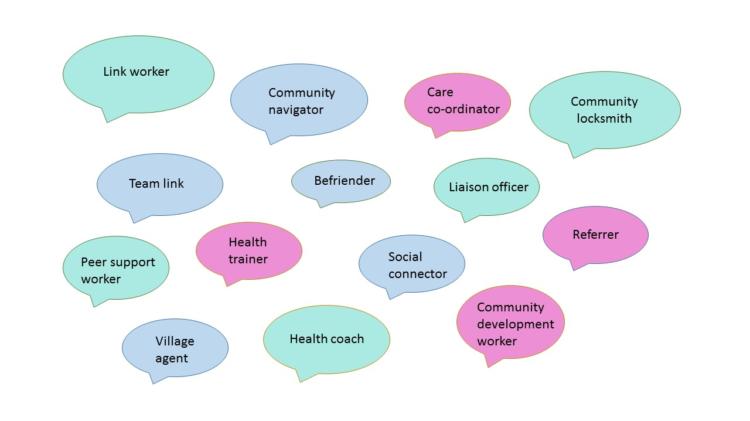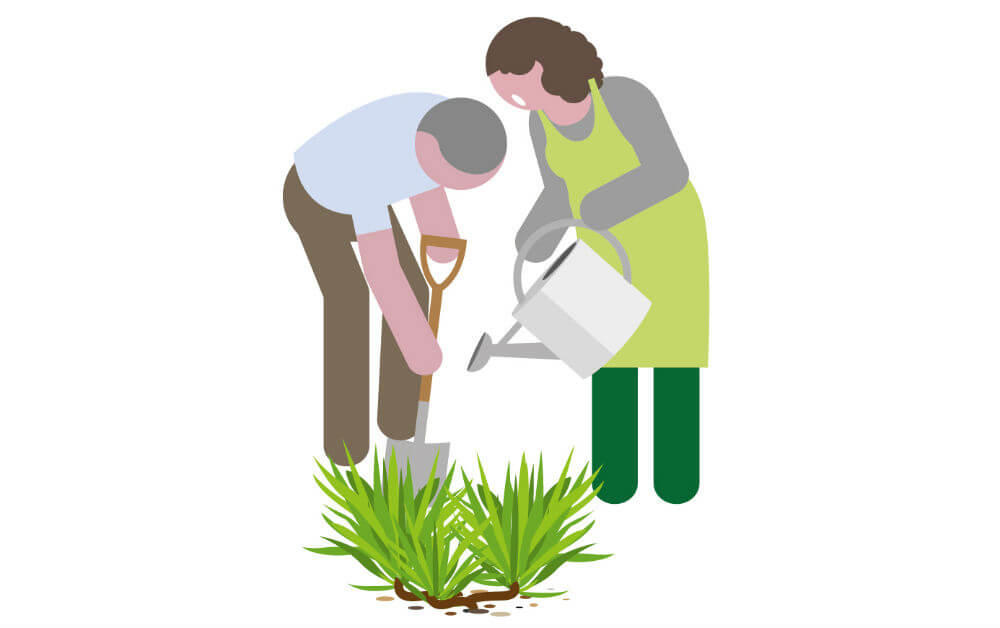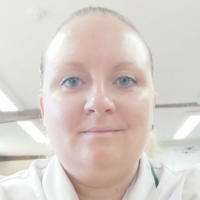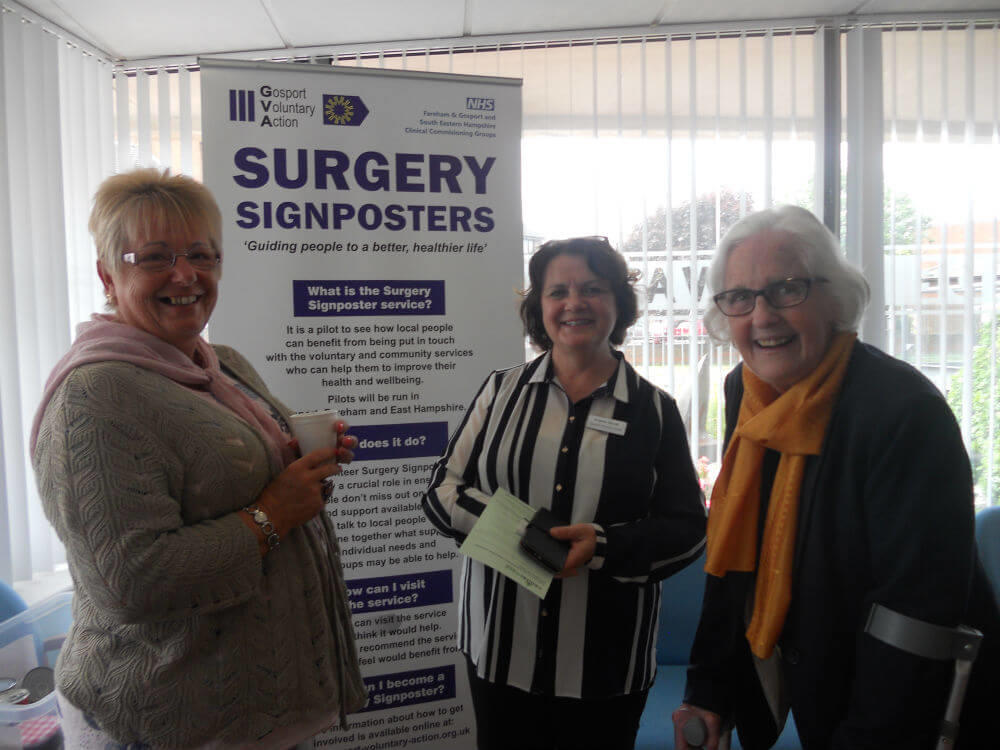What is a social prescribing with a link worker?
In cases where a person needs more support than active signposting can provide, it may be appropriate to refer them to non-medical link workers.
They connect people of all ages to community groups and other agencies for practical and emotional support. Link workers can be referred to from outside the NHS, for example, from non-NHS osteopaths.
Link workers may be employed by the NHS or the voluntary sector. The NHS England link worker model is based on link workers being employed by primary care networks (groups of GPs). To find out more about NHS link workers in your local area, contact your local GP surgeries. You should also explore whether there are other social prescribing services in your community.
Annex A of NHS England’s social prescribing summary guide has more information about the role of NHS link workers and a draft job description. A link worker competency framework for link workers is also being developed.
We asked AHPs what they call the people currently doing some or all of the link worker role in their area. There was a wide range of responses including:

When should I refer to a link worker and when should I take on the role of social prescriber myself?
This is likely to depend on the type of AHP you are and the type of work you are doing with a person. AHPs are more likely to undertake social prescribing themselves when they are already providing long-term intensive support to a person as part of their job role.
This is more likely to be the case for Occupational Therapists and Physiotherapists than for Radiographers or Operating Department Practitioners. However, even in these situations, when the people you are working with have a range of social issues which are impacting on their health and which you do not have the capacity or contacts to address, a link worker may be able to provide this support. For example, a Dietitian supporting someone to lose weight may find that their interventions are ineffective because the primary concern of the individual is financial or housing, and these issues need to be addressed before the person can focus on their diet.
The decision regarding when to refer to a link worker is particularly pertinent for AHPs whose roles already closely align with social prescribing. Occupational Therapists, for example, are experts in occupational science (the study of human participation in occupation), provide practical support to empower people to facilitate recovery and overcome barriers preventing them from doing the activities (or occupations) that matter to them.
They are very experienced regarding working collaboratively with others, and would work with link workers, carrying out joint visits if appropriate, to identify which people on their case load could be supported by a link worker. For further information please refer to occupational therapy’s role in social prescribing from The Royal College of Occupational Therapists.
Link workers should also have a clear pathway to enable them to refer people to AHPs when a person’s needs go beyond their level of competence.

How do I start?
When talking to a person you may become aware that they have wider needs affecting their health and wellbeing (e.g. social isolation). Have a ‘What matters to you?’ conversation to ascertain whether active signposting or social prescribing might help support them to meet these needs.
This PHE blog on brief advice, motivational interviewing and health coaching provides some ideas about starting conversations about health and contains links to training and other resources that might be helpful.
Find out whether you have any local NHS link workers (contact your local GP surgeries) or link workers based in local voluntary sector organisations. Make contact with them and find out how they can support you and your clients.
Case studies: Social prescribing with a link worker
Raz Choksi, Orthoptist, Low Vision Clinic
As an Orthoptist, I specialised in the field of low vision. Low vision is a term used in the UK to refer to visual impairment that cannot be fully corrected with spectacles or contact lenses. People diagnosed with low vision can have differing levels of impairment and the low vision service looks at how a patient may need help with everyday tasks such as reading, mobility, cooking and watching TV, through the use of low vision aids, as well as support a patient with their emotional wellbeing.
Our support service relies heavily on the eye clinic liaison officer (ECLO) who is the hospital’s low vision clinic link worker. These ECLOs are often employed by the Royal National institute of Blind People (RNIB).
This case is about a 78 year old lady who has many general health problems including having a stroke and type 2 diabetes. She was registered as sight impaired in 2018 by an ophthalmologist and referred on to the low vision aid clinic having been told there was nothing else the ophthalmologist could offer.
This lady lived on her own, had carers to help her and although she used a walking frame at home she would only use a wheelchair outdoors for the fear of falling. She missed carrying out basic cooking tasks in the kitchen and used to love to read. Her sight restricted her from reading basic cooking instructions, reading medicines bottles to using a mobile phone. She was starting to feel increasingly isolated and described episodes of hallucinations.
The low vision aid clinic prescribed her a magnifier to help with reading and anti glare filters to help her with bright lights indoors and outdoors. She was then referred on to and seen by our ECLO for further advice and support. The ECLO referred this patient to a rehabilitation officer for the visually impaired (ROVI), a RNIB officer who checks what benefits and concessions they can receive from being registered as visually impaired as well as a free living with sight loss course (LWSLC).
This is a two-day course run by local organisations for the blind to make them aware of all the local services, network with other local people who have sight impairments and other local support groups and activities available to the sight impaired. The patient was offered telephone counselling due to her feeling down and her having hallucinations, a phenomenon referred to as Charles Bonnet Syndrome. She was offered the use of free audio books to get her back into enjoying books and a technology advice session to help her use her smart phone.
As a low vision clinic it is vital we have the support of an ECLO within the hospital for a more holistic approach in patient care. The above patient is just an example and we can be faced with many challenges such as patients needing access to employment, help within the education setting, especially for children and young adults, independent living, housing, use of guide dogs and some patients who love to participate in sports, which is why we renamed the service as the Low Vision Support Service.
In an audit carried out by the service in 2017, 100% of our patients stated that they would recommend our service to other visually impaired people. I feel this service offers a more structured and sympathetic approach to patient care for the visually impaired which not only creates better communication with other local services but can offer the patient reassurance and the confidence that they are being fully supported.
Shaun McBride, Paramedic
In the ambulance service, we regularly attend to patients with very poor social health who struggle to access other health services - those who are housebound due to frailty or physical health problems, patients suffering homelessness and those with complex mental health problems.
This presents paramedics providing unscheduled care in a patients home environment unparalleled opportunities to assess and manage the social issues which are frequently also found. Due to the episodic nature of paramedic care, referral to a link worker is a vital tool for paramedics in order to facilitate long-term, quality management of social health concerns.
In my practice, I have often found referral to a link worker useful for patients who have multiple & complex physical, mental and social health problems, especially where these clearly interact and therefore would benefit from a more detailed and holistic assessment by a link worker.
An example I frequently encounter is where physical health conditions such as Chronic Obstructive Pulmonary Disease (COPD) are causing simultaneous muscular de-conditioning, loneliness and mental health problems. Another example might be where mental ill health, unemployment and substance misuse create a cycle that needs a more focused assessment to break.
Other patients where I find referral to a link worker useful are patients who I think may struggle to take full advantage of a social activity, perhaps due to confidence or lack of independence, and the long-term relationship and care provided by a link worker might be beneficial. For example, I've found this useful with frail and elderly patients, patients with mental health issues, or those with learning disabilities.
Lastly, it is particularly useful when working in a geographical area you are less familiar with, which is often the case in the ambulance service. A simple referral can ensure your patients receives the social care you feel they require from a knowledgeable local source. I also use active signposting in my practice to address less complex, often singular, social concerns that I encounter, and where I feel giving further information is sufficient for the patient to be able to resolve their issues.
Examples from my practice might include giving patients the phone number of a mental health or stop smoking hotline or to letting someone know about the existence of a particular service or activity offered in the area, such as a walking group or free adult education class.
Laura Murton, Occupational Therapist, St Helena Hospice

Here at St Helena we cover the 16 beds on the ward, a variety of groups in two locations, out-patients clinics and sessions and the community for North East Essex and part of Mid Essex. We see anyone within our catchment who has a life limiting illness- this can include cancers, neurological conditions, respiratory conditions, cardiac conditions and dementia.
We have links with the local community and acute hospitals, neuro rehab team, cardiac services, breathlessness services and other community-based services ran by companies such as Anglian Community Enterprise (ACE) and Provide. At St Helena we are a charity and rely on the generosity of the public and donations, we do receive some funding from the local authority. Currently the Clinical Nurse Specialists, OTs and Physios complete core assessments and are regularly the first face-to-face contact with our patient group. During these assessments we would identify any needs and signpost onto other relevant services.
Within our catchment area we have Community 360 also known as my social prescription. We can refer onto these by phone or email and patients and families can self-refer. Community 360 are also a charity and provide services such as befriending, transport, financial advice and have access to community services in order to signpost people to meet their needs.
The main issue we face is due to the complex needs of our patient group many services will not accept them due to mobility needs, nutritional needs or transport needs. This is a gap that needs addressing.
Contact Laura by email.
Christine O'Brien, Dietitian, Community Dietetics

As Community Dietitians, our practice has always taken a multi-faceted approach to helping patients, beyond promoting an understanding of food and nutrition. To help patients obtainsupport in areas of health and wellbeing, weight management, smoking cessation, alcohol, exercise and mental health we refer to an innovative one stop shop known as Live Well Stay Well Bucks (LWSW).
The LWSW programme holds information on easily accessible, local, free or subsidised programmes. Patients are provided with signposting to as many different areas as they would like and are not limited resolving to one issue at a time.
We are also striving to bring advice and signposting to those who we do not see directly. To achieve this we are working closely with Care Navigators, who are stationed in each surgery across the county, providing social prescribing and signposting for their patients. We have held a stall at their starter conference explaining our services and how the Care Navigators can signpost people to them. We are also booked to train at their upcoming study day to provide more detail.
A similar network of Cancer Champions has been trialled by Macmillan in 11 surgeries across Buckinghamshire and we are intent of being part of the roll-out that will see Cancer Champions in each surgery with specific knowledge about support and advice services available to their registered patients.
Our team will support these Champions through training and provision of a ‘Nutrition in Cancer Prevention Pack’ for those Living with and Beyond Cancer in the community. Not only will we provide support for those who are no longer seen regularly by Oncology teams but we are also hoping to capture those who perhaps felt there was no further support for them once their medical journey was complete. The packs contain nutrition information, reliable evidence, signposting to local support both professional and voluntary, and opportunities for feedback such as through patient groups.
Other ways we hope to facilitate social prescribing is by disseminating the packs to Community Cancer Clinics set up in our Community Hospital Hubs, Community Nurses as well as Support Group Volunteers and broadcasting our packs through the Thames Valley Alliance, Buckinghamshire County Council and LWSW.
For more information, please contact Christine.
Helen Paton, Occupational Therapist, Acute Hospital Setting
I work in an acute hospital setting and when a patient is referred to me, my role is to complete an initial interview to establish the patients previous abilities and needs and how their comorbidities have been affecting their functional abilities.
Mr B has a diagnosis of Parkinson’s Disease. He has been living well with this for the past 20 years. He was admitted to hospital following a fall outdoors. There was no acute medical reason for Mr B to remain in hospital and he was referred to occupational therapy for falls assessment. Mr B lived alone in a ground floor flat and had no relevant equipment in situ. In addition, he had no carers and had not had a shower for a long time as he is not able to get in to the bath and the shower is over the bath.
Mr B would walk to his local shops daily and this was his only means of social interaction. He reported that he was having approximately four falls a day prior to admission. These would be a combination of falls at home and falls outdoors. More recently Mr B had struggled to get up from the floor. He had no pendant alarm and reported that recently he had fallen whilst mowing the lawn and had to wait for someone to pass by to help him.
I discussed and agreed a number of strategies for managing his risk of falling, such as rails in his home, a bath board to enable him to have a shower, velcro for his shoes and also a pendant alarm for home and in the garden.
It was also agreed that Mr B might benefit from social and emotional support as he is fairly isolated. He was not aware of any other services that may be able to support him to live as independently as possible in the community. I made a referral to the community OT and also to the health navigator (from Provide) to complete an assessment with Mr B in his own home to discuss support with accessing the community, such as groups.
The most common challenge that we face is that people do not appear to be open to the idea of health navigators and social prescribing. However, during the OT assessments, I was able to build a rapport and where difficulties were identified solutions were discussed and options given. Ultimately, the OT gives options and does not dictate what should happen. The referrals were collaborative supporting Mr B’s goals.
Laura Smith, Renal Dietitian
I am a Renal Dietitian who as part of my role sees patients who attend one of the local dialysis units. One of my patients is a middle aged man who attends dialysis three times a week.
He has been seen by the renal dietitian team for some years. He used to come to pre-dialysis with a relative who did the cooking and encouraged him to eat well. He is a very fussy eater and reports to go full days without eating much at all. He does drink milk, fizzy drinks and has occasional takeaways. His weight has been up and down but has continued to be obese despite poor intakes of food reported. He also has a background of anxiety and depression.
I started seeing him in recent years. He reported at this time his main concerns were how to support his relative who had dementia and was starting to be difficult to persuade to eat. On subsequent visits as well as providing dietetic support to him, I also gave overall advice around how to support better intakes of food in somebody with dementia.
Each time I saw him he seemed more and more fed up and to be feeling very unsupported. I therefore tried to signpost him to Age UK. Another time I saw him he was really unable to focus on himself. It was apparent despite trying to get support through his GP and other services that these were not helping him. I therefore looked into what support was available. I sent a referral to Signpost for Carers in the local area detailing my concerns. I have recently double checked with Signpost for Carers if they had been able to give him any support.
They explained that he had been given some emotional support and given information about what additional local support was available. He has been contacted more recently and given support to look at getting lasting power of attorney for his relative. He is also finding meditation helpful and has been offered a dementia course to attend.
Simone Davis, Community Navigator, Bristol Community Health
Patricia is a lady in her 60’s who was referred by occupational therapy to the Community Navigators service through the rehab centre at Inns Court, Knowle where she was staying for two weeks following being in hospital. Patricia lives in a flat, a complex for older people and has carers come in once a day, her washing done once a week and has a personal alarm should she fall in her flat.
Unfortunately for Patricia the majority of the residents in her complex are in their 80’s and 90’s and have different interests and hobbies. She has been in her flat for two years but following the death of her husband four years ago she has become increasingly isolated and not been involved in the community as much. The decision to give up driving following being in hospital was difficult because it gave her independence and would increase her loneliness and isolation.
Simone, a Community Navigator, first visited Patricia at the end of 2017 and they discussed how Patricia might like to be helped and any interests that she had. Following her initial visit Simone came back to Patricia for a follow up session after she had found out about what was going on in the community. Simone helped get Patricia a bus pass (she had not needed one before now) and to get a passport.
Simone then found out about a knitting group and a coffee morning that was being held in the area that Patricia used to live in and accompanied her to them. Going to the groups involved getting on a bus, the first time Patricia had been on a bus for years. Simone also told her about the CAT bus which goes to local shopping centres and supermarkets on a weekly basis.
Patricia is also going to book in some sessions for physio and is keen to sign up to the ‘Staying Steady’ course in Hengrove once the information comes through. Joining a gym that isn’t claustrophobic might be something she will look into going forward. When asked would she recommend the Community Navigator Service to other people she said “It’s a very good idea, very helpful and so friendly. Although younger than me, Simone and I always had something to talk about, and she was so friendly, and always on time!”
*the person’s name has been changed for confidentiality.
For more information, please contact Simone Davis.
Gosport Voluntary Action's Surgery Signposting Service
In 2015, as part of Gosport’s successful, holistic, Vanguard ‘Better Local Care’ Project, Gosport Voluntary Action (GVA) recruited and trained a small project team and an eclectic selection of volunteers - with a range of community, health and relevant lived experience.
This dedicated team were then established within Southern Health NHS Trust’s Willow Group surgeries - delivering free much valued c40 minute ‘listening and active signposting’ face to face or telephone appointments, currently in three GP surgeries, weekly and in a local residential care home monthly.
Demand is increasing year on year, with a 42% increase in 2019. Over 40% of patients the active signposting service supports have mental health related issues, with another 20% relating to social isolation and 20% personal welfare needs.
The highest referrers unsurprisingly are GPs but the positive impact/word of mouth has resulted in self-referrers being the second highest, followed by nurses. The most common social needs presented are social isolation, depression and bereavement. Eight in ten (83%) of people helped by the surgery signposting service felt better/much better afterwards.
The Surgery Signposting Service engaged as part of Southern Health’s ‘Frailty Task & Finish Group’ – bringing an invaluable wealth of community information and expertise supporting a range of Clinicians, including Allied Health Professionals, Care Navigators, Health Connectors and in the future hopefully, Link Workers. This holistic approach benefits clinicians, patients and volunteers, allowing precious clinical time to be targeted to where it is needed most.

For more information, please contact Angela Gill.
Example of Link Worker referring to Occupational Therapist
A female, aged 82, who has been widowed for four years, has long term COPD and is on permanent oxygen. One daughter lives locally but has her own family commitments so tries not to bother her too much. She has tried the traditional clubs where she mixed with others of a similar age, but says these are not for her. She had an active social life when her husband was alive and would like to get out of the house a couple of times a week to socialise more. Also likes the idea of someone coming to the house to chat with her.
This lady was previously very active and sociable but had become very isolated and disengaged with the life she wanted to lead, she had low expectations in her ability to manage her breathing problems.
The Occupational Therapist referred her to the local social prescribing service to work with her to help her overcome these barriers and to focus on what matters to her, which was to feel more engaged with her local community.
After a personalised conversation with the Navigator, she was provided with local University of the Third Age groups and activities, local community groups and activities, befriending services. They also discussed the potential for some kind of volunteering role and as there is no difficulty with talking on the telephone, a telephone friend volunteer role with Silverline is being considered. She also had issues with getting to places so the Navigator provided details of DialARide, Voluntary Car Service.
The Social Prescribing Navigator will re-contact in the near future to provide whatever support is needed to connect with her preferred options. The Navigator has already provided face-to-face feedback to the Occupational Therapist, and this highlights how link workers and occupational therapists can work collaboratively for the best outcomes for patients, delivering seamless holistic services and ensuring people are able to take advantage of social prescribing despite living with complex conditions.
© National Association of Link Workers
